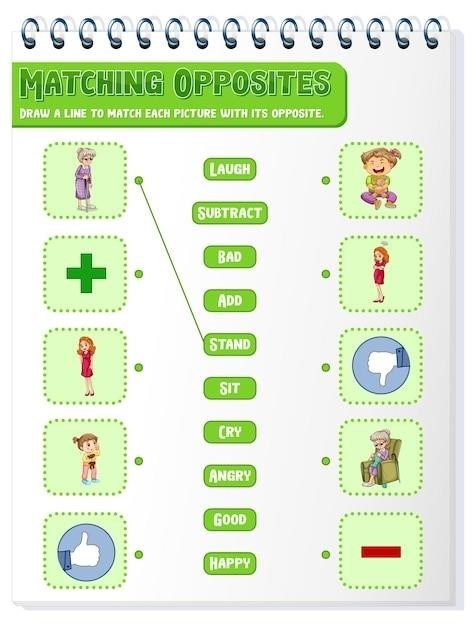
one step instructions aba examples
What are One-Step Instructions in ABA?
One-step instructions are simple‚ clear directions that focus on one action or task at a time. These concise directives are designed to be easily understood and followed‚ making them particularly beneficial for individuals with autism spectrum disorder (ASD);
Understanding the Concept
In the realm of Applied Behavior Analysis (ABA)‚ one-step instructions play a crucial role in teaching individuals with autism spectrum disorder (ASD) essential skills. These instructions‚ as the name suggests‚ involve a single‚ clear directive that focuses on a specific action or task. For example‚ “Give me the ball” or “Touch your nose” are one-step instructions. The simplicity and clarity of these instructions ensure that the learner can readily understand and follow them‚ facilitating skill acquisition and reducing confusion.
Benefits of Teaching One-Step Instructions
Teaching one-step instructions in ABA offers numerous benefits for individuals with autism spectrum disorder (ASD). By focusing on a single action at a time‚ these instructions simplify the learning process‚ making it more manageable for learners with challenges in processing information. This approach lays a strong foundation for more complex skills by promoting attention‚ comprehension‚ and the ability to follow directions. Furthermore‚ mastering one-step instructions enhances communication skills‚ fostering a better understanding of verbal cues and promoting effective interaction with others.

Examples of One-Step Instructions in ABA
One-step instructions are commonly used in various settings‚ including home‚ school‚ and therapy sessions.
Basic Instructions
These are simple directions that focus on a single action‚ often involving objects or body movements. Examples include⁚
- Touch your nose.
- Give me the red ball.
- Clap your hands.
- Stand up.
- Put the book on the table.
These instructions are typically used to teach basic skills like object identification‚ following directions‚ and motor skills. They provide a foundation for learning more complex instructions.
Instructions for Daily Living Skills
One-step instructions are essential for teaching daily living skills. These instructions help individuals learn routines and become more independent. Examples include⁚
- Brush your teeth.
- Put on your shoes.
- Wash your hands.
- Make your bed.
- Set the table.
By breaking down complex tasks into manageable steps‚ individuals can learn to perform these essential activities with greater ease and confidence.
Instructions for Social Interactions
One-step instructions can be incredibly helpful in teaching appropriate social interactions. By breaking down social skills into manageable steps‚ individuals can learn to navigate social situations with greater confidence. Examples of one-step instructions for social interactions include⁚
- Say hello to your friend.
- Ask someone how their day is going.
- Thank someone for helping you.
- Share your toys with a friend.
- Take turns playing a game.
These simple instructions help individuals learn basic social skills‚ fostering positive interactions and building stronger social connections.
Teaching Strategies for One-Step Instructions
Several effective strategies can be employed to teach one-step instructions‚ ensuring successful learning and skill development.
Errorless Learning
Errorless learning is a powerful technique that minimizes the chance of mistakes during instruction. This method involves providing immediate and consistent prompts to ensure the learner responds correctly. For instance‚ when teaching a child to follow the instruction “Touch red‚” you would physically guide their hand to touch the red object. As the learner demonstrates understanding‚ the prompt is gradually faded‚ allowing them to independently perform the task. This approach is particularly effective for individuals with autism who may benefit from a structured and predictable learning environment. By minimizing errors and maximizing success‚ errorless learning fosters a positive learning experience and promotes confidence in the learner’s ability to follow instructions.
Prompting and Fading
Prompting and fading is a systematic approach to teaching one-step instructions by providing support and gradually reducing it as the learner gains independence. Initially‚ prompts‚ such as physical guidance or verbal cues‚ are used to ensure successful completion of the task. For example‚ when teaching a child to follow the instruction “Give me the ball‚” you might initially point to the ball and say “Give me the ball.” As the child demonstrates understanding‚ the prompts are gradually faded‚ leading to independent following of instructions. Fading can involve decreasing the intensity of the prompt‚ such as moving from physical guidance to verbal cues‚ or reducing the frequency of prompts. This gradual process allows the learner to develop self-reliance and confidence in their ability to follow one-step instructions.
Reinforcement
Reinforcement plays a crucial role in teaching one-step instructions by increasing the likelihood of desired behaviors. When a learner successfully follows an instruction‚ they receive a reinforcer‚ which can be anything that is motivating and enjoyable for them. Reinforcers can be tangible items‚ such as a preferred toy or snack‚ or social rewards‚ such as praise or a high-five. The effectiveness of reinforcement depends on the individual learner and their preferences. It is important to identify reinforcers that are highly motivating for the learner to ensure consistent and effective learning. Consistent reinforcement helps learners associate successful instruction-following with positive outcomes‚ making them more likely to repeat the desired behavior.
Applications of One-Step Instructions in ABA
One-step instructions are a fundamental tool in ABA therapy‚ with applications across various areas of development.
Developing Language Skills
One-step instructions play a crucial role in developing language skills in individuals with autism. By providing clear and concise directions‚ therapists can help learners understand and respond to verbal cues‚ expanding their receptive language abilities. This foundation is essential for building more complex communication skills. For example‚ an instruction like “Touch the red ball” encourages the learner to identify colors and objects‚ while “Give me the book” promotes understanding of prepositions and actions. As the learner progresses‚ one-step instructions can be used to introduce new vocabulary‚ grammatical structures‚ and social language skills‚ fostering their overall language development.
Improving Behavioral Regulation
One-step instructions can be instrumental in improving behavioral regulation in individuals with autism. By providing clear expectations and consistent routines‚ therapists can help learners develop self-control and manage their behaviors more effectively. For example‚ instructions like “Sit down” or “Wait your turn” can help learners understand and follow social rules and expectations. These clear directives can also help individuals develop coping mechanisms for challenging situations‚ such as instructions like “Take a deep breath” or “Count to ten” when they are feeling overwhelmed. By consistently using one-step instructions‚ therapists can help learners develop a sense of predictability and control‚ leading to improved behavioral regulation and reduced challenging behaviors.
Building Independence
One-step instructions play a crucial role in fostering independence in individuals with autism. By teaching learners to follow simple directions‚ therapists can empower them to perform daily tasks and routines autonomously. Instructions like “Put on your shoes” or “Brush your teeth” can help learners develop self-care skills‚ promoting a sense of accomplishment and self-sufficiency. As learners progress‚ therapists can introduce more complex instructions related to daily living skills‚ such as “Make a sandwich” or “Wash your hands.” This gradual increase in complexity helps individuals gain confidence and develop the ability to manage their own needs and responsibilities‚ ultimately leading to greater independence in various aspects of their lives.

Resources for One-Step Instruction Activities
A variety of resources can help parents‚ educators‚ and therapists find engaging and effective activities for teaching one-step instructions.
Online Resources
The internet offers a wealth of resources for one-step instruction activities. Websites like Teachers Pay Teachers provide a marketplace for educators to share and purchase original educational materials‚ including resources for teaching one-step directions. YouTube offers a wide array of videos and tutorials on teaching one-step instructions to children with autism‚ featuring demonstrations and practical tips. Online communities and forums dedicated to ABA therapy and autism education can provide support‚ advice‚ and links to relevant resources.
Printable Worksheets
Printable worksheets are a valuable tool for practicing one-step instructions. They offer a structured and engaging way for learners to practice following directions. Websites and resources dedicated to ABA therapy often provide free or downloadable worksheets that focus on specific skill areas‚ such as identifying colors‚ shapes‚ or objects. These worksheets can be used independently‚ with a therapist‚ or in a classroom setting. They often feature simple pictures and clear instructions‚ making them accessible to learners of varying abilities.
Interactive Games
Interactive games provide a fun and engaging way to practice one-step instructions. Many online platforms and educational apps offer games designed specifically for skill development in children with autism. These games often involve simple instructions‚ such as “click on the red ball” or “drag the object to the box.” The interactive nature of these games makes them motivating for learners‚ encouraging them to participate and practice their skills. Some games even provide visual cues and feedback‚ helping learners understand the instructions and track their progress.
One-step instructions are a fundamental building block for skill development and independence in individuals with autism.
The Importance of One-Step Instructions in ABA
One-step instructions are a cornerstone of ABA therapy‚ serving as the foundation for building more complex skills and promoting independence. They provide a structured and predictable learning environment‚ allowing individuals to focus on mastering one task at a time. This approach breaks down overwhelming tasks into manageable steps‚ fostering a sense of accomplishment and reducing frustration. By starting with simple instructions‚ therapists can gradually increase complexity‚ ensuring that individuals progress at their own pace. This systematic approach is particularly beneficial for individuals with autism‚ who may experience difficulties with understanding and following multi-step instructions. Moreover‚ one-step instructions provide a clear framework for communication‚ fostering understanding and reducing misinterpretations. They promote the development of essential life skills‚ from daily living routines to social interactions‚ ultimately enhancing overall well-being and quality of life.
Future Directions for Research
While one-step instructions are a valuable tool in ABA‚ further research is needed to explore various aspects of this technique. One area of interest is the impact of different instructional formats‚ such as verbal‚ visual‚ or multimodal‚ on learning outcomes. Investigating the effectiveness of one-step instructions across various developmental stages and abilities would also be beneficial. Further research could delve into the role of motivation and reinforcement in enhancing the effectiveness of one-step instructions. Additionally‚ exploring the generalization of one-step instructions to different settings and situations would provide valuable insights for practitioners. Understanding the interplay between one-step instructions and other ABA interventions‚ such as task analysis and errorless learning‚ is crucial for optimizing treatment strategies. These research endeavors will contribute to a deeper understanding of the nuances of one-step instructions‚ ultimately leading to more effective and personalized interventions for individuals with autism.